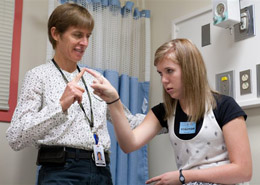 Kassidy Brewer does not remember mowing the lawn on August 4, 2008 or saying “my head is vibrating” shortly after she finished the job. Her mother, Donna, vividly remembers what it was like to hear those words and to watch her healthy, sparkly-eyed daughter sweat profusely and involuntarily flex her arms over her chest. “There’s no time to call 911,” she thought.
Kassidy Brewer does not remember mowing the lawn on August 4, 2008 or saying “my head is vibrating” shortly after she finished the job. Her mother, Donna, vividly remembers what it was like to hear those words and to watch her healthy, sparkly-eyed daughter sweat profusely and involuntarily flex her arms over her chest. “There’s no time to call 911,” she thought.
Donna was right. Kassidy, an athletic 13-year-old, who had set cross-country running records at school and earned her black belt in karate in just four years, was being physically challenged in a brand-new way. Her ongoing journey toward health would require 11 surgical procedures; recovery from a stroke; extensive physical, occupational, and speech therapy; the involvement of the entire family (the “Brew crew”); and the prayers of family, friends and well-wishers from around the world.
But all that lay ahead. Before Donna and her husband, Kassidy’s father, Kevin, reached the hospital closest to their home, Kassidy had vomited, collapsed in her mother’s arms and stopped breathing. A CT scan revealed a massive hemorrhage in the back of her brain, caused by a congenital arterio-venous malformation (AVM), which is an abnormal mass of blood vessels.
AVMs impede normal blood flow to brain tissues. Kassidy’s impacted her autonomic functions, including temperature regulation, respiration and more. She was in serious trouble. “Rady Children’s Hospital-San Diego was uniquely suited to help,” says Dr. Michael Levy, Professor and Head of Pediatric Neurosurgery and Kassidy’s surgeon. “Our facility is particularly able to care for pediatric AVM patients, given the multidisciplinary approach required for their care and the technical difficulties involved when operating. Our state-of the-art equipment allowed us to handle her complicated case.”
Given the critical nature of her AVM, Kassidy was transferred by helicopter to Rady Children’s. Her condition was critical and, over the next few days, her fever rose and her organs began to fail. “Aggressive support for Kassidy’s heart and lungs kept her alive,” says Dr. Brad Peterson, Medical Director of the Critical Care Unit. “There was no room for error.”
For the next three months, as doctors, nurses and other experts oversaw Kassidy’s physical care, her family remained at her side. While she lay in a non-medically induced coma, Donna, Kevin, and Kassidy’s two sisters, Danielle and Lexi, stayed with her in shifts. Often, Lexi’s boyfriend, Travis, joined the group. Danielle’s fiancé, Paul, kept things in shape at their home. The Brew crew massaged Kassidy’s skin and moved her limbs constantly. Kevin started a blog on Caring Bridge, a free service sponsored by Rady Children’s, to inform friends and relatives of her condition. In 12 months, the site was visited more than 155,000 times.
The Ronald McDonald House provided room for the family to stay close. Donna left the Hospital campus only twice. After three weeks, Kevin went back to work, returning each night after a three-hour commute each way to the Los Angeles area. Lexi began her senior year at school, but soon switched to a homeschooling program so that she could help with the bedside vigil. Danielle was at the Hospital constantly.
Kassidy remained in various stages of a coma, and the family confronted good news and bad. For an agonizing two weeks, she experienced neurostorms, which are common in patients with brain injuries. Her muscles would involuntary seize up, and she would cry. The storms lasted all day, about three minutes each with minute long respites. To lessen their impact, Kassidy’s joints were injected with botox; her limbs were put in casts. In his blog, Kevin referred to Kassidy as a mustang, fighting to make progress, making efforts to win the battles and the war. These neurostorms were one of many battles.
Despite the gravity of Kassidy’s condition, her room was peaceful and full of positive energy. Though she was in a coma for her 14th birthday, her family decorated her room and brought 100 cupcakes to share. “The Brewers are the kind of family that makes medicine rewarding,” says Dr. Peterson. “Everyone who took care of Kassidy went home feeling good because they are such a loving, caring family.”
Kassidy went home in mid-October with plans to return for therapy and surgery when she was stronger. She had to relearn to swallow, laugh, and walk. She ate for the first time on Thanksgiving and talked on December 5.
Following a series of embolizations which use glue and coils to destroy the feeding arteries to the AVM, she returned to Rady Children’s in April for an 11-hour surgery definitive surgery performed by Dr. Levy. He was able to cure her using intraoperative thermal imaging (which uses temperature to define the extent of the remaining AVM) and intraoperative angiography. Kassidy was able to return home in less than 48 hours.
Kassidy is now a full-time high school sophomore. She continues to work hard with her therapy, showing courage and great competitive spirit. Though she knows she can’t yet will her body to everything she used to be able to accomplish with ease, she is an athlete, and she knows how to win. She’ll get there.
The San Diego Union-Tribune Kids’ Newsday, October 2009
For an update on Kassidy and to watch a video of her amazing recovery, click here.